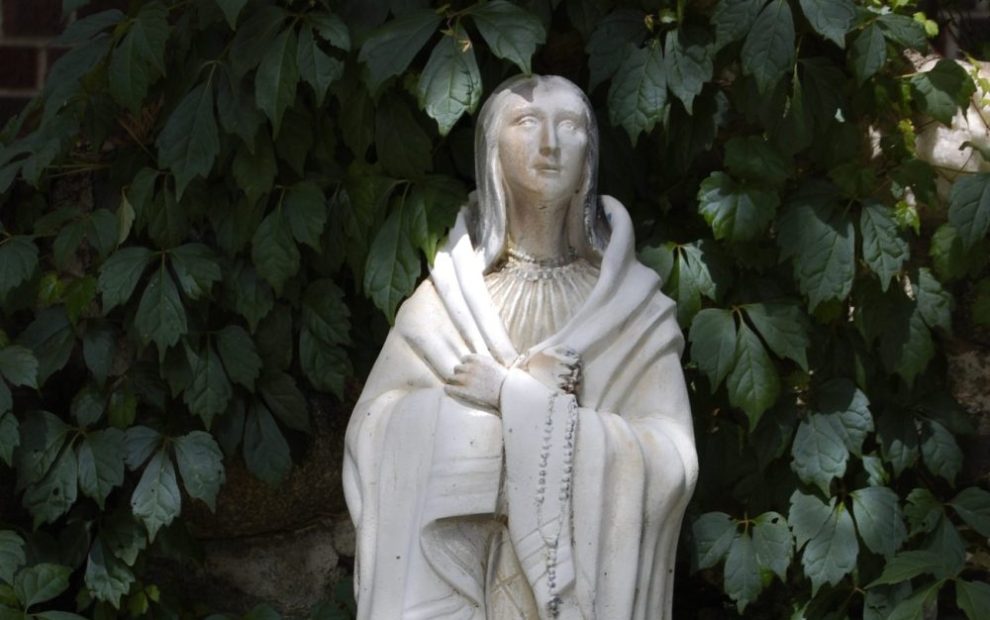For me, it started with an unsuccessful attempt at growing vegetables on a shady apartment porch. The next year, it was a few potted tomato plants on the patio. Then came more tomato plants the next year, plus a try at growing potatoes in a stake of old car tires. This led to building some garden beds and starting to compose our family’s food scraps. Each passing year, each season continues to bring little lessons and more plants.
Through gardening, I have found a better and ever evolving appreciation for the blessings of the natural world. I am certainly not alone in feeling a deeper connection with God by putting my hands in the dirt. Throughout history, there have been many Catholic saints who developed a love for the natural wonders of God’s creation. As springtime approaches, so too is it time to get out the gardening trowels, prepare the garden beds, grab some seeds, and start planting. Here are some saints and other well-known Catholics to help inspire you this gardening season.
St. Fiacre of Breuil
St. Fiacre was an Irish priest and hermit who lived during the 7th century AD and is the patron saint of gardeners. The saint was raised in a monastery, where he eventually became a priest. St. Fiacre longed for solitude and decided to sail to France to try and find it. The bishop of the French city of Meaux allowed St. Fiacre to establish a hermitage for himself in a forest in the region of Brogillum (later known as Breuil). There, he spent his time cultivating a vegetable and herb garden, praying, fasting, and taking in and caring for weary travelers who passed by his way.
St. Fiacre was known for his extensive knowledge of herbal medicines as well as many miraculous healings. Towards the beginning of his time at his hermitage, some hunters came upon St. Fiacre’s garden. These hunters were welcomed openly and were amazed to find such a lovely haven amidst such a somber forest. Soon, the word was out about St. Fiacre’s garden, with more and more travelers stopping to visit. It became so popular that the saint needed to go back to the bishop and request more land to accommodate those coming to see him and his garden.
Gardeners can call on the intercession of St. Fiacre to aid them in their endeavors during the growing season. He can also help remind us of the quiet tranquility the practice of gardening can be, even during the most hectic moments.
St. Isidore and St. Maria de la Cabeza
St. Isidore is the patron saint of farmers and rural communities. He was born in Madrid, Spain in 1070. Starting at a young age, St. Isidore worked the land of a wealthy landowner, a job he did for the majority of his life. He was known for living a simple, devout life of prayer and work on the land. St. Isidore went to daily morning Mass and could often get so lost in prayer that he’d be late to start the day’s work. St. Isidore married Maria Torribia (who became known as St. Maria de la Cabeza or St. Maria of the Head due to her head being preserved as a relic after her death, which is said to have brought rain during dry seasons.)
Sts. Isidore and Maria lived a simple life of prayer, work, and service. St. Maria always kept a pot of stew on as it was customary for her husband to bring home anyone he could find who was hungry. A number of miracles have been attributed to St. Isidore. One of the most well-known is once, a fellow worker complained to the landowner that St. Isidore was once again late for work that morning. The landowner went to the field to find St. Isidore deep in prayer while an angel plowed the field for him.
The work of Sts. Isidore and Maria can serve as an inspiration to see gardening in a simple, prayerful manner. Who knows, maybe an angel will come help you out in your garden someday.
St. Ansovinus
St. Ansovinus is the patron saint of agriculture and for the protection of crops. He served as the Bishop of Camerino, Italy during the late 700s and early 800s. St. Ansovinus’ patronage of agriculture stems from miraculous stories that the saint was able to feed those in need. One story states that he was able to produce a seemingly infinite amount of food from just a small pot, no matter how many mouths there were to feed.
On another occasion, St. Ansovinus was distributing grain from a regional granary to the hundreds and maybe thousands of people starving in the area. After being informed that the grain had run out, St. Ansovinus implored his helpers to look again, for them to find the granary miraculously full once again.
St. Ansovinus can help remind us to share the fruits of our labor with others, whether that be giving some tomatoes to a friend, picking a flower for a loved one, or even giving a plant to someone to start their own garden.
St. Kateri Tekakwitha
St. Kateri was an ndigenous woman who converted to Catholicism. She is known as the Lily of the Mohawks and is the patron saint of ecology. Born of the Algonquin and the Mohawk people in 1656, St. Kateri’s (born Tekakwitha) youth was filled with turmoil. While just a child, her entire family contracted smallpox, which had been brought to the Americas by Europeans, probably via slave ships. Tragically, both her parents and brother died from the disease. St. Kateri survived and was adopted by her aunt and uncle.
Smallpox was only one of the hardships she experienced due to colonization. Conflict arose between the Mohawk tribe and the French and Dutch colonists over the local fur trade. The French set fire to villages, forcing Kateri and her family to flee. Eventually, the Mohawks and the French signed a peace treaty. It was then, when she was around 11, that St. Kateri encountered Jesuit missionaries and first learned of Christianity. At 17, St. Kateri fled from her home to avoid being forced into an arranged marriage. She found shelter with a Jesuit missionary and confessed her desire to become a Christian. From then on, she studied the faith and lived a life of prayer and service with the Jesuits. This is also when she took the name Kateri (or Catherine) after St. Catherine of Siena.
A strong tie to the land and care for creation are important in many Indigenous spiritual traditions. St. Kateri kept this close to her heart, spending much time in the woods conversing with God and listening to God speak to her through nature. In this way, she bridged the gap between the traditions of her youth and those of her new found Catholic faith.
St. Kateri’s witness can serve as a reminder to gardeners to listen for God’s voice in every weed plucked, every seed sown, and every flower tended to. St. Kateri is also the inspiration for the St. Kateri Conservation Center, a nationwide Catholic-based organization that promotes the intersection of faith and ecology.
St. Francis of Assisi
Likely one of the most well-known Catholic saints, St. Francis of Assisi is often noted for his love of nature. He is the patron saint of the environment and of animals. St. Francis’ love of nature stemmed from his intense love for God. He was able to perceive God’s hand in the beauty of creation. St. Francis would address all creatures as “brother” or “sister,” including not only animals but other natural phenomena like water, fire, wind, the sun, and the moon. (See his wonderful poem, “The Canticle of the Sun,” a beautiful ode to God and creation.)
There are many stories of St. Francis interacting with wild animals in unexpected, miraculous ways. A famous story that illustrates the saint’s feelings on nature is his sermon to the birds. While walking from town to town, St. Francis noticed a group of birds gathered in a tree. St. Francis saw nature as a mirror of God and, at that moment, felt compelled to preach to this group of birds on being gracious for the wonders God provides. The birds listened intently, and when St. Francis was done, they flew away forming the shape of a cross, seemingly to show they understood St. Francis’s sermon.
St. Francis of Assisi stands as a testament and reminder to appreciate the beauty of nature. Next time you’re out in the garden, take a moment to admire the wonder of God’s gifts…and maybe take some time to converse with a nearby bird or two.
Peter Maurin
Peter Maurin was a Catholic thinker, activist, and co-founder of the Catholic Worker Movement, along with Servant of God Dorothy Day. He grew up in a poor rural region of Southern France. He moved to Canada and then to America in the early part of the 20th century. In 1932, Maurin sought out to meet Dorothy Day after reading some articles she had written for various Catholic publications. Being an avid talker, Maurin poured out his radical Catholic vision to Day. His ideas inspired the start of the Catholic Worker newspaper, as well as a larger movement. The initial ideas of this new Catholic Worker movement were three-fold: one, opening houses of hospitality for the needy; two, have regular “round table” discussions on the political, social, and religious issues of the day; and three, the establishment of small scale farming communities as a way for people to get back to the land.
Catholic Worker communities still endure to this day. Houses of Hospitality, or Catholic Worker Houses, can be found all over. While the back-to-the-land portion of Maurin’s vision did not become as widespread as houses of hospitality, there are still a number of Catholic Worker farms that can be found across the country and other parts of the world. In his day, Maurin set up what he called an “agronomic university” at a 28-acre Catholic Worker Farm in Iowa. Here, Maurin led others in a life of laboring with their hands on the farm, prayer, and intellectual study, embodying the Catholic monastic notion of ora et labora, which translates from Latin to “work and pray.”
Peter Maurin can help us remember, as we each tend our own gardens, there is a wider community of gardeners out there with whom we can connect with, share ideas, and learn from.
Pope Benedict XVI
Catholics today will know Pope Benedict XVI. Benedict, born Joseph Ratzinger, was elected Pope in 2005, succeeding Pope St. John Paul II. Pope Benedict was known for having a strong, theological mind. One aspect of Benedict’s papacy that is not always so well-known is his strong convictions on ecological issues. When it comes to Popes and ecology, many today think of Pope Francis and his encyclical, Laudato si’ (On Care for our Common Home), which is certainly an important document in itself. However, it is Pope Benedict who has been dubbed the “Green Pope” for his promotion of environmental issues.
Pope Benedict authored and contributed to a number of writings that deal with the environment and care of creation, including his second encyclical, Caritas in Veritate (Charity in Truth), his 2009 book The Environment (Our Sunday Visitor), and his 2012 book Ten Commandments for the Environment (Ave Maria Press), just to name a few. Pope Benedict once spoke on visiting a botanical garden and reflecting on the wide array of flowers our Creator had provided our world. In the same way, the Pope reflected on the diverse garden of saints throughout the ages we can look to, from all walks of life, each uniquely living out the love of God in their lives.
A respect and care for creation is something of utmost importance. In his 2010 message for World Peace Day, Pope Benedict spoke passionately about the need to respect creation, our obligation not to neglect the nature, and of the “covenant between human beings and the environment, which should mirror the creative love of God, from whom we come and towards whom we are journeying.”
These holy men and women stand as reminders for all gardeners to keep God’s creation close to their hearts. It doesn’t take being a saint, however, to take a moment to treasure the beauty of gardening, of cultivating, of participating in nature. May God be with everyone this gardening season.
Image: Wikimedia Commons/Cmichael1977 (CC BY-SA 3.0), Statue of St. Kateri Tekakwitha














Add comment